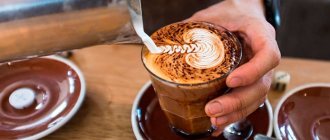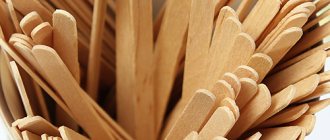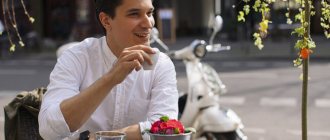Espresso
The classic espresso cup is called a demitasse (from the French demi-tasse, “half cup”). It has a small volume, only 60-90 ml, and is most often made of porcelain. Demitass serves ristretto, espresso, macchiato - small coffee with a drop of milk foam.
A special feature of demitasses suitable for espresso is their thick walls. Thanks to them, you will have time to enjoy your drink before it starts to cool down. By the way, the cup must be warmed up before preparing espresso - espresso is prepared directly into the cup, and if it is cold, the drink will have time to cool down during preparation, which will significantly worsen its taste. If your coffee machine does not have a function for heating dishes, you can simply hold hot water in the cup for a while, and only then prepare espresso in it.
In terms of volume, demitasse is also suitable for double espresso, but this drink is often served in a larger cup, about 150 ml. Firstly, in this case the aroma is revealed more clearly - this is especially noticeable if you rotate the cup a little before the first sip so that the cream starts to move. Secondly, in a large cup it is more convenient to mix the cream and make the drink more homogeneous and balanced in taste. And thirdly, double espresso is not a drink that must be drunk before it cools down: its taste will develop differently at different temperatures, so you can take your time and savor every sip. However, thick walls are also desirable for such a cup, for the same reason: so that the drink does not cool down too quickly.
The shape of an espresso cup also matters: most often, its inner surface will be rounded and tapered downwards, ovoid - this way the drink will be better distributed in the cup. In addition, Brazilian multisensory perception researcher Fabiana Carvalho has shown that round shapes are associated with sweetness, and in a rounded cup the taste of espresso is perceived as sweeter. The edge of the espresso cup is also rounded, which enhances this effect and allows you to feel the body of the drink as creamier.
Fabiana Carvalho's project The Coffee Sensorium is dedicated to the study of specialty coffee in the context of multisensory perception of taste. Photo by sprudge.com.
The founder of the Parisian roasting company L'Arbre de Cafe, Hippolyte Courti, tested more than 400 coffee cups and created his own - a perfectly spherical shape. This cup is made of sandstone and has a rough, “granular” surface that feels reminiscent of ground coffee. Another detail that Kurti paid attention to was the thin edge of the cup. In his opinion, thick edges make our brain perceive espresso as something “heavy” - heavy, dense, viscous. When there is no barrier between our lips and the drink, we don’t load our brains with expectations and try coffee as if “from scratch.” Kurti uses these cups in his own coffee shop, and they can also be found in some restaurants in Paris.
And a little about color: according to my observations, the brightest taste of espresso is felt in a cup that is white on the inside - perhaps because this creates the maximum contrast between the coffee and the dishes. On a bright or black background, the taste is somewhat “lost.” Manufacturers of coffee cups most often make the cups white on the inside, but the outside of the cup can be any color - it’s a matter of taste and mood.
Double espresso in a Redneck Ware 80 ml ceramic cup.
HOW TO POSITION A SPOON CORRECTLY
For those who prefer to drink without sugar, you can safely skip this point. However, the vast majority of us are sweeter lovers, so the position of the spoon is as important to us as the utensils or freshly ground Bongiorno Nord.
So, let's serve a spoon. As you remember, first we place a saucer in front of the guest, then we place a napkin on the right. It is on this that the sugar spoon is placed. Remember that the spoon should be on the same side as the handle of the coffee utensil. After stirring the sugar, do it slowly, without knocking on the walls; you should not leave the spoon in the drink - this is a sign of bad taste. Putting it on a saucer nearby, you can safely drink it.
Drinking at home
Drinking coffee at home, of course, allows you to not be so strict about etiquette. However, if you are having a big celebration, then some rules will still be useful.
So, the drink is served at the end of the feast. They remove all plates and food on trays, leaving the table clean. Serve from the coffee maker in a coffee set - preferably a porcelain one. The napkin is not placed under the saucer, as you remember, we make a nice triangle and place it next to it. If your drink comes from a coffee maker, then a separate cup is brewed for each guest (carob) or choose a volume for several guests at once (drip). Coffee is prepared immediately before serving and should be drunk immediately after preparation. Don’t forget to preheat the dishes to at least 40 degrees so that the drink retains its taste, aroma, and warmth longer. The sweets are placed first, followed by the cutlery. Then the coffee pot is brought out. If, in addition to sweets, there are also snacks in the form of small sandwiches, then a knife is also placed nearby.
To the table of contents.
The owner walks around the guests from right to left, while he stops on the right hand next to each guest. The owner serves guests in the following way: he holds the saucer with his left hand, and pours coffee with his right hand. The cup is filled 2/3 full so that guests can add milk or cream if desired, which is served warm.
Of course, it’s much easier to brew a lot of coffee at once and put everything out on a tray, but the service on the table looks very nice. However, it depends on your preferences. Don't forget to check when serving cappuccino or espresso from a coffee machine whether you should add something to taste: milk, cream, cinnamon, cocoa. Either way, you should put them on the table so everyone can add what they want. The cups are removed from the left side of the person sitting. Remember also about water, which is best chilled; even at home, many will pay attention to this nuance, noting that you know everything about coffee etiquette.
What you should not do under any circumstances: you should not dip sweets into hot liquid, you should not wash down unchewed food with hot food, or knock loudly with a spoon while stirring the sugar. Everything should be smooth, measured, and should be enjoyable.
Atmosphere
For a special mood when serving, you should pay attention to some details. This is especially true for coffee shops; it will also come in handy at home. The table is usually covered with a soft tablecloth in pastel colors to match the drinks. You can also add a cute touch with a vase of flowers. There is no need to invent huge compositions or order expensive bouquets. You can easily collect a bouquet of wildflowers, placing them in a tall vase on the side of the table, placing several small candles nearby, believe me, this will be quite enough. Your guests will notice that you did not want to splurge on luxury, but only wanted to achieve the main thing - a pleasant atmosphere so that everyone can enjoy a cup of Bongiorno.
To the table of contents.
← Return to blog
Cappuccino
When choosing a cappuccino cup, you should pay attention to the shape: a slightly narrower one at the bottom, with a wide neck, would be optimal. For example, this is what Loveramics look like - the official cups of the world latte art championship. This cup is convenient for mixing coffee and milk, and the wide surface allows you to create designs using milk foam. The suitable cup size for this drink is 150-190 ml. Professional cappuccino ware also has thick walls to maintain a stable temperature of the drink. In addition, in heavy and thick-walled containers, the taste is perceived as creamier, which is also very important for maximum enjoyment of cappuccino.
Where will they give you a discount on coffee in your glass?
Coffee house "8/25"
Address: st.
Novodmitrovskaya, 36 Discount: 10% on drinks in your own glass
"Alpaca and Coffee"
Address: Bolshoy Golovin lane, 25
Discount: 10% on drinks in your own glass
"Grain and Leaf"
Address: Khokhlovsky per., 7
Discount: on coffee to go in your own glass
"Sharing my soul"
Address: st.
Pyatnitskaya, 54, building 1 Discount: 10 rubles on coffee to go in your own glass
Coffee house "Espressium"
Address: Bolshaya Sukharevskaya square, 16/18, building 1
Discount: 10% on drinks in your own glass
Nord Coffee
Address: st.
1st Tverskaya-Yamskaya, 12 Discount: 15% on drinks in your own glass
"Socket and coffee"
Address: st.
Pokrovka, 17, building 1 Discount: 10% on drinks in your own glass
Central Coffee
Address: st.
Seleznevskaya, 11a, building 2 Discount: 20% on coffee to go in your own glass
"Airplane"
Address: st.
Staraya Basmannaya, 6, building 3 Discount: 10% on all drinks in your own glass
Starbucks
In all coffee shops of the chain
Discount: 20 rubles on drinks in your glass
Flat white and latte
There are no clear requirements for glassware for these drinks; in different establishments they are served in different ways: in glass glasses, in cappuccino cups, in ordinary mugs... Unfortunately, I did not find reliable information about why this happened, so I share my assumptions.
A flat white is not just a “small strong cappuccino”, it is a small drink (up to 200 ml) made with double espresso (or double ristretto) with a minimum amount of foam. It is often served in a cut glass, and this is another difference from cappuccino. In general, this is convenient: you can visually estimate the height of the milk foam - it should be about 5 mm. Since the drink is small in volume, you don’t have to worry about it getting cold in the glass, because you can drink it quickly. And we don’t expect the same creaminess as in a cappuccino from a flat white, so tricks like thick walls and a rounded edge are not particularly important here.
The tradition of serving latte in a glass apparently comes from latte macchiato, a three-layer coffee cocktail served in an Irish glass. For latte macchiato, the appearance of the drink is especially important: a layer of warm milk, a layer of espresso and a layer of milk foam - the smoother and more contrasting they are, the higher the professionalism of the barista (but this is not certain). Nowadays, a latte is understood as a large portion of coffee with milk - about 300-350 ml. It is prepared in different ways: some pour ready-made espresso into heated milk (without worrying about the layers, however), others add milk to espresso, creating latte art on the surface. When serving a latte in a transparent glass, you can admire the pleasant shade of coffee with milk, but from a tall mug it is more convenient to drink it, and it will cool down more slowly. A large wide cup (like for a cappuccino), in my opinion, is not the best option for a latte, since there is less milk foam in this drink and it will be too thin on the surface of a large cup.
Recipes for making coffee with chocolate
There are many recipes for making coffee with chocolate. They differ not only in the list of ingredients, but also in the temperature of the drink. Some people like hot coffee, others prefer cold coffee.
Classic chocolate coffee drink
Classic chocolate-coffee drink
To prepare traditional mocha you will need:
- freshly ground coffee
- chocolate
- sugar
- milk
First you need to brew the espresso. Then you should melt the chocolate bar in a water bath, gradually pouring milk into the container. Without bringing to a boil, the mixture is removed from the heat and added to the coffee. The drink can be sweetened to taste and decorated.
Spicy
Spicy coffee with chocolate and spices
This type of recipe originated in Brazil, where they like to add various spices to coffee.
The drink requires the following components:
- Arabica
- mineral water
- bitter chocolate
- sugar and salt
- cream
- cardamom and cinnamon
Coffee and spices are poured into the Turk, filled with water and placed on low heat. After a couple of minutes, foam should appear on the surface of the liquid. At this point, the Turk is quickly removed from the heat until the foam settles. This action should be repeated twice.
Having brewed the main drink, move on to the second ingredient - chocolate. It, together with the cream, is sent to a water bath. A couple of minutes will be enough to melt the chocolate. The resulting mixture is combined with hot strained espresso and sugar is added if desired.
Drink spicy coffee hot.
Cold moccacino
Cold Moccacino
This cocktail is perfect for cooling and relaxing in the summer heat. To prepare it take:
- ground Arabica or Robusta
- sugar
- mineral water
- cream (whipped)
- milk
- chocolate
- ice
- mint
First the espresso is prepared. Beat milk, sugar and chocolate with a mixer, gradually increasing the speed. After 3-4 minutes you should get a lush cream. Then this mass is mixed with cooled and strained coffee, ice is added, and decorated with whipped cream and mint.
Purover
When brewing coffee in various pour-overs, we want to maximize its taste and aroma. And here the dishes we use also matter. Decanter
A decanter, or server, is a container in which pour-over coffee is brewed (and served). It can look different, but the most important thing is that it should have a wide base and a narrowed (but not too narrow) neck. For example, you can look at Hario decanters or remember what a Chemex looks like - it is both a funnel and a decanter.
Decanters are designed to aerate coffee, an idea coffee professionals borrowed from sommeliers. When the drink rotates in the server, volatile substances will be released, which will make the aroma of the coffee brighter and help you better feel its taste. In addition, this will mix the different layers of coffee extraction and make the drink more homogeneous.
Cup
Coffee brewed in pour over is served in small wide cups or smooth glasses. Usually you don’t pour the whole drink into a cup, but add small portions from the decanter. This is done in order to try coffee at different temperatures: as it cools, the coffee changes, revealing its acidity and sweetness, and the nuances of taste are better felt in a warm drink than in a hot one. Properly brewed coffee will be tasty even when it has completely cooled down.
It is worth mentioning separately about the shapes of cups for black coffee, since the difference in shape allows you to experience dramatic changes in taste. One of the most vivid taste experiences for me was getting acquainted with KRUVE glasses, the creation of which took into account many scientifically proven factors that influence taste. They are made of borosilicate glass and have different shapes: the first glass is narrow and long, the second is onion-shaped, more open and with a wider surface area. As a result, the same coffee in the first glass is perceived as sweeter and denser, and in the second - as light and bright.
Here are Figgjo Oslo cups from Tim Wendelboe. Tulip, with a wide base and tapered top, is designed for low acidity coffees and helps bring out the sweetness. Split, in which both the base and top are expanded, is intended for acidic coffee - both aroma and acidity are revealed brighter in this form. Open is a U-shaped cup for a balanced, fruity coffee. The fun thing, Tim says, is playing with different shapes and different coffees, changing the perception of the taste.
Photo andershusa.com.
In the big city: how mobile coffee became a symbol of life in the metropolis
Photo: m24.ru
Coffee in a paper cup has become a symbol of active city life. This is no longer a trend that arose thanks to American cinema, but a daily necessity or habit. According to experts, the percentage of Russians who regularly consume coffee is almost 80 percent. How the takeaway coffee service developed in the capital and why the love of an invigorating drink is dangerous - in the material M24.ru.
Consumer culture
Today it is difficult to track who was the first to implement it in the capital, but we can assume that it was McDonald's in 1990. In any case, the demand for coffee in a paper cup appeared only at the end of the 2000s. Fashion was most strongly influenced by American films set in big cities. The heroes of the films “The Devil Wears Prada” or “Sex and the City” walk along the city streets with a paper cup in their hand, bring coffee to work or sit with a hot drink on a park bench.
in the USA for several decades. The fashion reached Russia late, but even then, not all city coffee shops offered to take drinks with them. The impetus for development came with the opening of the American coffee chain Starbucks in the capital in 2007, which was followed by other establishments in the city. Of the two consumer cultures - fast American and slow European - Moscow has followed the path of New York.
Anastasia, culturologist
If we talk about cinema and coffee, we can’t help but mention Jim Jarmusch’s wonderful 2003 film Coffee and Cigarettes. This film further strengthened the inextricable concept of “coffee plus cigarettes” in the minds of consumers of the aromatic drink. The film shows a completely different culture of coffee consumption; the drink, together with tobacco, seems to erase the barrier between people and add warmth to the conversation. Well, how in the 1950s families went to visit each other with a pie, but now you can open your soul over coffee and a cigarette. However, the anti-tobacco law is moving such intimate gatherings from cafes and bars to the streets - this is another reason for the growing popularity of takeaway coffee.
Photo: TASS/Sergey Bobylev
Another factor influencing the popularity of the service is price. As a rule, coffee to go is cheaper. For comparison: a cup of cappuccino in one of the popular chain coffee shops costs 229 rubles, and the price of coffee to go here is 159 rubles. Some coffee shops also regularly hold promotions, during which the price of “mobile” coffee can drop to almost 80 rubles.
With the increasing demand for coffee to go, new establishment formats have appeared in the city: kiosks and vans, specializing exclusively in quick service. Their menu includes the most popular types of coffee drinks: cappuccino, latte and espresso at affordable prices.
Vadim, marketer
As you know, by the middle of the twentieth century, coffee had become a commodity second only to oil in terms of annual sales. However, laziness took its toll. Sales of coffee beans and ground coffee were at very low levels, while sales of instant coffee were increasing annually. For example, if we talk about the United States, thanks to three enthusiasts who opened a tiny Starbucks coffee shop on the corner of Pike Place Market in downtown Seattle, a real revolution took place. The first customers came in out of interest, tried real coffee and realized what instant rubbish they had previously called “coffee.” When it comes to takeaway coffee, marketing has also played a big role. Firstly, drinking coffee on the street has become fashionable, it has often become part of the style - watch any film about New York, there will definitely be a successful person with a paper cup of coffee in his hand. Secondly, no matter how strange it may sound, there is freedom of expression here. How many eco-friendly reusable coffee cups, thermos mugs and tumblers have been invented that can be decorated as you please by just inserting a sheet with the necessary design under the outer transparent part of the mug; I have even seen umbrellas that, instead of a classic handle, have a special stand for a coffee cup.
The development of coffee naturally affected the growth of consumption of the drink. Compared to 1998, the level of coffee consumption in Russia has increased by more than 50 percent and reached 250 thousand tons per year. The percentage of Russians who regularly consume coffee remains consistently high – 76-77 percent in 2009-2013. And a decline in the coffee market is not expected in the near future.
The downside of fashion
Photo: TASS/Sergey Savostyanov
With active city life and the availability of coffee, it can be difficult for city residents to track how many cups of the drink they consume daily. Doctors recommend limiting caffeine consumption: in large doses it is not only harmful to health, but can also cause addiction.
Doctor of Medical Sciences, Professor of the Research Institute of Nutrition of the Russian Academy of Medical Sciences Alla Pogozheva told M24.ru about the beneficial and negative properties of coffee, the development of addiction and optimal doses of the drink.
Thus, among the beneficial properties of coffee: increased tone, performance, attention and endurance. The drink improves your mood and gives you a feeling of cheerfulness. In small doses, it is useful for older people to prevent Alzheimer's and Parkinson's diseases. Coffee also constricts cerebral arteries and reduces migraine headaches.
The drink is also a source of antioxidants. In its soluble form there are as many of them as in black tea, but less than in green tea. Eating two to three cups of roasted grains provides your daily intake of antioxidants.
Photo: TASS/Maxim Novikov
Some nutritionists believe that coffee can affect body weight. Caffeine increases thermogenesis, which promotes weight loss. However, according to Alla Pogozheva, there are no serious scientific studies that would confirm this.
Excessive consumption of coffee can negatively affect the state of the cardiovascular system, provoke a rise in blood pressure and arrhythmia, and also cause intoxication of the body. When drinking coffee in large quantities, there is also a loss of vitamins, magnesium and calcium. The drink is not recommended for people with increased excitability, tachycardia, bladder diseases and glaucoma. If you have diseases of the gastrointestinal tract, you should not drink coffee on an empty stomach.
Elderly people, athletes, pregnant women and nursing mothers should limit their drink intake (no more than two cups per day).
Photo: TASS/Grigory Sysoev
Consuming more than 250 mg of caffeine per day can cause addiction - coffee addiction. In this case, refusal to drink will be accompanied by headache, apathy, drowsiness and discomfort. However, it all depends on a person's sensitivity to caffeine.
“Each person is individual and each has a gene that regulates cytochrome P450, which is responsible for metabolizing caffeine in the liver. For some, this metabolization is slow, they are called caffeine-sensitive people, and they should not indulge in this drink. For people with rapid metabolization, the number of cups per day can be greater,” said Alla Pogozheva.
Victoria Salnikova, Victoria Ryazantseva.
Topics: Opinions , City trends: everything that worries the capital
Why it's better not to drink from paper
Even putting the environment aside, paper cups are not the best choice for coffee. Firstly, they are thin and light - which means that black coffee will burn your hands, and a perfectly prepared cappuccino will lose its creaminess. Secondly, the taste of paper will be added to the pour over descriptors - and this is not what you want to smell in good coffee. Thirdly, if you go outside with a paper cup in winter, the coffee will cool down too quickly. Finally, we cover the coffee with a lid, blocking the perception of aroma and depriving ourselves of the brightness of the taste.
And a little more about textures
I am a kinesthetic person, and tactile sensations are very important to me, including (I would even say, especially) from the dishes from which I drink my favorite drink. In coffee shops, I always pay attention to how much I like holding the cup in my hands. My favorite cups are made by the ceramic workshop Redneck Ware: they have a rough surface, very pleasant to the touch, and a smooth, glossy edge - that is, with each sip you can simultaneously feel two completely different textures. This makes the cup experience brighter.
In general, the ideal coffee cup can be absolutely anything: created according to all the rules or sculpted by hand in a ceramic workshop, bought at your favorite coffee shop or accidentally found at a flea market... The main thing is that you like the coffee you drink from it!
Read the article on our channel in Yandex.Zen
HOW TO HOLD A CUP CORRECTLY
When you drink Bongiorno Espresso, the saucer must be lifted from the table along with the cup. In your left hand you hold a saucer, and with your right hand you drink in small sips. This applies to espresso, doppio, macchiato.
If you prefer cappuccino or latte, then you can safely leave the saucer on the table when you bring the drink to your mouth.
But don’t forget the main thing: never put the bowl on the table, only back on the saucer, otherwise this will completely kill the good opinion of you as a coffee lover. It is also very important to drink without haste; this is an unspoken rule that is followed throughout the world.
To the table of contents.











